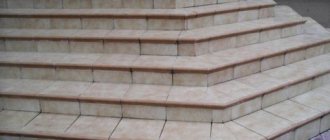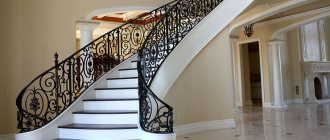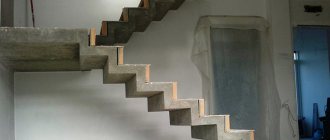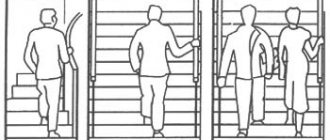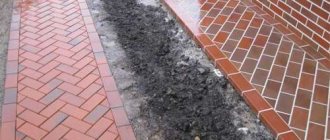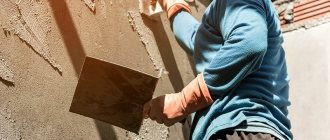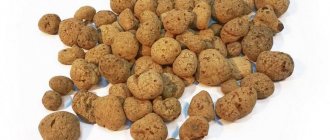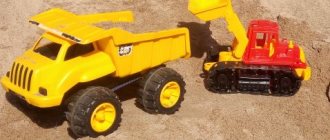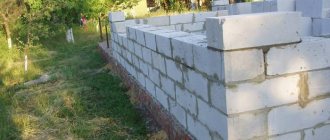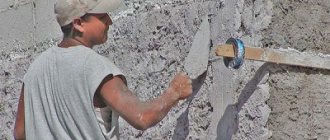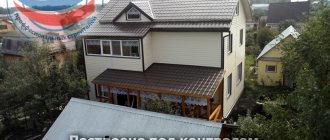Many houses have stairs. Most often it is made of wood. Sometimes the question arises of how to cover the wooden steps of a staircase to extend its service life and give it a beautiful appearance. To solve this issue, you should determine approximately the type of wood from which the staircase parts are made. After all, materials are usually coated with varnishes and paints. But each type of wood has its own structure and pattern. Sometimes you want to emphasize them.
Image 1. Wooden staircase with patterns.
How to paint a wooden staircase outdoors
Wood is often used to decorate entrance stairs and porches. The material needs protection from weather influences and pests. There are a number of products available for this purpose that will extend the life of the product and improve its appearance.
Since outdoor stairs are subject to more severe loads, you need to use suitable varnishes and paints to paint them. Of these materials, the best option would be to treat the surface with natural drying oil paint. Also, finishing can be done with alcohol-based, alkyd or polyurethane-based varnishes. Enamels and paints based on artificial drying oil are not suitable for outdoor work because they are afraid of dampness.
Painting a wooden staircase outdoors
Rubber coverings
The use of moisture-resistant impregnations for wooden stairs
- stain;
- wax impregnation;
- carpet covering;
- rubber pads.
Using stains of different colors you can achieve any shade of wood while maintaining its visible structure. Wax impregnations also color parts, creating a water-repellent polished surface. Wax impregnation requires regular updating. Carpet, rug or carpet is used as carpeting. To prevent feet from slipping on the steps, the covering is secured with small nails, Velcro, special clips and fasteners. This coverage:
- makes the steps warm;
- muffles noise;
- gives beauty to the staircase;
- prevents feet from slipping.
To prevent feet from slipping, pieces of linoleum, rubber and polyurethane are placed on the steps. These materials hardly wear out and do not slip.
Anti-slip porch coverings made from crumb rubber are very popular. The raw materials for their production are used car tires crushed into crumbs and polyurethane glue.
We suggest you familiarize yourself with how to paint a wooden staircase in a house to the second floor
They are produced in the form of overlays or mats on steps, monolithic and roll coverings, as well as in the form of modular tiles or paving stones. If you find this topic interesting and relevant, be sure to watch the video in this article.
Installation methods
Rubber coatings are produced both on a self-adhesive base and in aluminum profiles with mechanical fastening. There are also products that need to be glued to the base using polyurethane glue, or fastened using flat or corner profiles or directly with dowels and screws.
Anti-slip porch mats and overlays are simply placed on the steps and held there by their own weight.
Let us describe, as an example, the technology for laying monolithic rubber steps.
Installation instructions:
- Preparing the foundation. The steps must be smooth, level, dry and clean. The tiles can be glued to a concrete, wooden, metal or polymer base.
To prevent moisture from accumulating on them, it is advisable to make a slope of 1-2 degrees towards the street.
- We prepare a primer from polyurethane glue with turpentine or acetone in equal proportions.
- Apply a continuous layer of glue to the steps using a roller or spatula.
Primer treatment of the base
- We cut the non-slip steps for the porch at the back, according to the depth of the tread. The scraps, if desired and of a suitable size, can be used for cladding the riser.
The edge of the step can be used as a riser
- We lay the step on the base, pressing it tightly to the surface.
You will be able to use the porch within 24 hours, provided the ambient temperature is above 10 degrees.
Gluing can be replaced with mechanical fasteners by screwing in self-tapping screws at a distance of 5 cm from the corners of the product, and making a step between them of no more than 50 cm. To increase the pressing surface, it is worth placing a washer under the screw head.
Mechanical fastening
Advantages
Finished products can withstand mechanical loads and temperature changes and are very resistant to moisture.
- Having sufficient thickness, they perform not only anti-slip, but also shock-absorbing and sound-proofing functions.
- The anti-slip effect is provided by the properties of the rubber itself. In addition, a relief can be applied to the surface, which reduces the risk of falling on the slippery surface of the porch.
- Even in the event of an accidental fall, the likelihood of serious injury will be lower due to the shock-absorbing properties of the coating.
The risk of injury from a fall is reduced due to the shock-absorbing properties of rubber
- When ice and snow freeze, the anti-slip coating for outdoor porches is easy to clean. You can impact it with hard, blunt objects without fear of destroying it. Whereas stone or ceramic tiles, as well as wood and concrete, do not withstand such a relationship.
- A thick layer of rubber muffles sounds. Perhaps this is not so important for street stairs, but the coating also has this property.
- Finally, the variety of colors is also a significant advantage. With the help of these materials, non-slip steps for the porch can be used to decorate the facade of the house, harmoniously blending them into the surrounding landscape.
Multi-colored treads
The cost of rubber products is quite high, but since their service life is at least 10 years, such design of a street staircase fully pays for itself.
We suggest you familiarize yourself with How to make fertilizer from grass for the garden
Choosing the color of steps and balusters
When painting wooden stairs, the color of the steps and balusters is selected to match the tone of the entire structure, which depends on the owner’s imagination or the features of the interior. If you want to highlight the beauty and characteristics of natural wood, it makes sense to use stain or clear varnish for painting.
Varnishing of balusters
In order to hide minor defects or fit the staircase into the overall interior, paints, varnishes and enamels of suitable colors are used. When treating a structure with varnish, experts advise choosing a matte version, which will hide minor imperfections in the structure without spoiling the overall impression.
Steps painted with matte varnish
Many people have recently given preference to patina when painting balusters. This option will allow you to choose any shade, while balusters painted in light or gray tones seem airy, white and turquoise options look very expressive, and gilded or bronze patination adds luxury to any interior.
Bronze patination of wood
When painting steps, you should follow the same rules as when processing the entire structure. It should be remembered that before starting to apply paint, the room and stairs must be clean to avoid dust or dirt getting under the paint, which can lead to stains and stains.
Since painting a staircase can take more than one day, the steps can be treated through one element. This will cause some inconvenience when walking, but will make it possible to use the stairs while painting.
Varnishes and paints for stairs
Before choosing a varnish, you need to get acquainted with its composition and application instructions, otherwise you will have to wash everything off and re-treat the surfaces, and this is very difficult to do. Varnish for wooden stairs is a solution that forms a durable film on the surface of the product, which can be transparent, matte or simply shiny. Types of varnishes:
Image 2. Lacquered staircase.
- alcohol;
- nitrocellulose;
- formaldehyde;
- alkyd.
Alcohol varnishes basically contain resin solutions. They dry quickly and are easy to polish. Their disadvantages include a low degree of frost resistance. This property does not allow them to be used outdoors. The moisture resistance of alcohol varnishes is also low.
Nitrocellulose compositions are much more resistant to atmospheric influences. These varnishes can be used outdoors. The solutions contain resins, colloxylin, and plasticizer.
Formaldehyde varnishes are the most durable. They are perfect for processing stairs. They contain formaldehyde resins. They adhere well to wood. The disadvantage of such varnishes is a persistent odor that takes a long time to disappear from a closed room. Products coated with this varnish remain transparent and attractive in appearance (image No. 2).
Image 3. Opaque varnish on the stairs.
Alkyd varnishes are recommended for use on the stairs of country houses, where the load is the least. The varnishes contain linseed and wood oils, which penetrate quickly and deeply into the wood. They are able to withstand mechanical loads well. Disadvantage: the coating deteriorates very quickly. This happens approximately 2 months after application. Therefore, it is not recommended to coat stairs with alkyd varnishes.
An opaque coating is often used to finish wooden products (image No. 3). It can hide design flaws. This coating can be obtained by applying several layers of varnish or paint (image no. 4). Before applying dyes, it is necessary to clean the surfaces from the previous coating (if there was one), sand and putty all parts, and prime them. Only after this paint or varnish is applied.
All varnishes are toxic. When working with them, it is recommended to use a protective mask or respirator. Such precautions prevent a person from getting poisoned. It is better to send household members out of the house before the work is completed.
To complete the work you will need:
Image 4. Staircase painted in several layers.
- bristle brushes;
- hair brushes;
- drying oil;
- turpentine;
- varnish or paint.
Bristle brushes are usually taken round. Before work, they are moistened in drying oil, washed in turpentine, then they can be used to apply varnish or paint. The work takes place in the following order:
- All surfaces of the stairs are cleaned of old coating.
- Dust is removed and the parts are covered with a layer of primer and putty.
- The varnish is applied in wide stripes and leveled. The brush should be held at a slight angle relative to the surface.
- The bristles remaining on the surface from the brush are removed.
The varnish should be stirred more often while working. All work can be easily done with your own hands.
Anti-slip products for the entrance area - practical and stylish
Proper design of the porch of a private house, multi-apartment residential or public building must necessarily include a special coating that reduces the risk of a person falling. Non-slip materials are now available in a variety of textures and colors. This makes it possible to give the entrance group a stylish and expressive look. Anti-slip special coverings for porches are made of aluminum, all kinds of abrasive materials, rubber, rubber.
The products we are interested in are made in the form:
- self-adhesive tape;
- roll materials;
- rugs;
- rubber crumb linings.
The choice of a suitable coating depends on the characteristics of a particular porch, the overall design of the building facade, and special requirements for anti-slip products.
Popular brands of anti-slip coatings - a short overview
Non-slip products are currently produced by many foreign and domestic companies. Russian consumers liked rubber coatings under the GUMMI brand.
To furnish a porch, tiles and rolled materials under this brand, made from crumbs, are usually used.
Such products contain a large amount of polyurethane binder component, which gives them unique wear resistance, increased elasticity and water permeability. GUMMI
products are not afraid of frost, they have a chic appearance, are easy to cut and install.
roll non-slip coatings are often used to decorate ramps and entrance areas of private housing constructions, shopping complexes, entertainment venues, public and office buildings .
These products are securely fixed on any flat and hard base (wooden, metal, asphalt, concrete) using self-tapping screws, angles and other fasteners.
EcoStep
products are frost-resistant, injury-proof, have an attractive appearance, and can be easily cleaned with plain water.
- Zig-Zag
are cellular mats and rolls from an Italian company that have excellent sound and moisture absorption properties. Such products are sold at an affordable price, can be used for a long time without breakdowns, and look elegant and stylish. - Festool
– anti-slip tapes in rolls 10 m long. Produced using modern technologies. Recommended for use at the entrance to public and residential buildings. - 3M
Safety-Walk
series ) - coatings that are ideal for arranging metal steps. The ribbons of this brand are made from environmentally friendly materials. Their service life is 2–3 years.
Anti-slip porch coverings are truly useful products. They protect a person from injury and make any porch brighter and more original. Choose the coating that suits you, taking into account its cost and technical characteristics.
Everyone knows firsthand how slippery the steps of a street porch can be after rain or snowfall. And some people even fell on them and received injuries. To protect yourself and your household or guests from such troubles, it is worth investing in anti-slip coating on the porch steps.
There are several types of materials capable of performing such a protective function. All of them will be described in this article, and all you have to do is choose the appropriate option.
Structurally, all types of such coatings can be divided into two types: the first in the form of narrow strips, strips and profiles and the second in the form of continuous coatings.
There are quite a few varieties of narrow overlays. Let's try to navigate their diversity.
Types of overlays
They produce anti-slip coating on the porch in the form of narrow strips from materials such as rubber, rubber, PVC, and abrasive-coated tapes. They can be combined with anodized aluminum profile.
| Image | Description |
| Ribbed strips on a self-adhesive base can be easily attached with your own hands to the horizontal edge of the steps. | |
| L-shaped overlays for finishing the edges of treads. | |
| Anti-slip porch pads made of frost-resistant rubber for external and internal stairs made of concrete, wood, metal, tile or stone. | |
| Unlike self-adhesive overlays, such strips and corners are installed on the steps during the process of covering them. The fastening points are covered with tiles or wood trim. | |
| Aluminum profile with one, two or three rubber or TPE liners. A worn liner tape can be replaced, while the profile fixed to the steps with dowels or screws remains in place. | |
| The L-shaped analogue of the previous lining can also have from one to three anti-slip strips. | |
| One of the most reliable solutions for making a porch non-slippery is an embedded profile with a replaceable rubber insert. | |
| Adhesive-backed strips coated with abrasive particles. They are produced in the form of strips and rolls of large width, which allows you to cut out anti-slip porch coverings of any shape and size. |
How to choose
When choosing one or another type of anti-slip pads, you should pay attention to the following parameters:
- Bandwidth.
It can be from 15 to 100 mm, and in the case of an aluminum profile, even more. - Its shape
is flat or angular. - Durability.
Abrasive belts have the shortest service life. Despite the fact that the fixation of hard particles is very strong, they wear out in 2-3 years.
- Additional functions.
These include the possibility of replacing the anti-slip liner. There are also covers that glow in the dark thanks to built-in photocells.
- Installation method.
If the porch has not yet been finished, you can consider embedded structures. In all other cases, in order not to spoil the steps, choose overhead or self-adhesive strips. - Price and release form.
Overlays can be sold in pieces of different lengths or in whole rolls, the footage of which is large for an ordinary porch of a private house. - Appearance, color.
The design of the entrance group is the calling card of your home, so even the shape and color of the strips glued to the steps should be in harmony with its exterior.
Perhaps the options shown below will help you with your choice
Manufacturers and prices
Today, purchasing an anti-slip coating for a porch is not at all difficult. In any specialized store they are presented in a wide range. Let's take a closer look at the most famous manufacturers and the cost of anti-slip coating:
- Self-adhesive tape Reparatie Winkel – 3600 rubles per piece (length 18 meters).
- Anti-slip coating made of GUMMI rubber - 1273 rubles per sq. m. meter.
- Cellular anti-slip coating Zig-Zag - 890 rubles per linear meter.
- Anti-slip coating for stairs EcoStep - 1223 rubles per square meter.
- Anti-slip tape Festool FS-HU 10M – 1062 rubles per roll (10 meters).
The anti-slip coating on the porch steps guarantees maximum safety and comfort of movement on the stairs in adverse weather conditions - during snow and rain.
Finishing steps for street stairs (video)
Finishing the steps of street stairs is an incredibly important stage in home improvement. After all, your safety in winter depends on how competently you select the material for this element. Think through all the nuances in advance, and you will get a comfortable and safe home!
- Author: admin
Rate this article:
- 5
- 4
- 3
- 2
- 1
(0 votes, average: 0 out of 5)
Share with your friends!
